"What can you see in the telescope?" This is the question I often get asked while setting up a telescope in a schoolyard or park. The problem is that with so many wonderful pictures available of the skies many people seem to have an unrealistic view of what the telescope can show them.
On the other side many people don't know just how well a small telescope can show them some objects. In particular the planets and star clusters that can be so beautiful in even a small telescope under urban, light polluted skies. The exclamations of wonder upon seeing Saturn for the first time in a scope are a pleasure to hear as people discover just what can be seen in a small telescope.
On this page I have tried to assemble a collection of pictures that accurately represent what can be seen in a telescope of 4 to 12 inches (10-30cm) in aperture. Often the view can exceed the photos shown here if conditions are right.
 The Moon
The Moon
Many people start using a telescope by looking at what they know how to find. Nothing is easier than the Moon. Not only easy to find, but wonderful to look at, the Moon is near enough that all of it's terrain readily reveals itself to a telescope; craters, mountains, valleys, fault lines, lava plains and rilles. The best place to look is along the terminator, the line between light and dark, where sunset or sunrise is taking place. Like sunset or sunrise on the Earth each little hill or crater wall casts long shadows, these shadows make the terrain stand out in relief. As the terminator moves across the face of the Moon during the month new terrain is revealed each day to those with the desire to explore our nearest terrestrial neighbor.
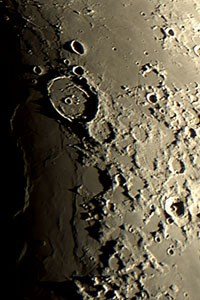
Planets
Easy to find in the sky and always worth the effort are the other planets of our solar system. All of the planets can be found in a modest scope, though Pluto requires a slightly larger scope as well as planning and a little skill. These other worlds are often dynamic and changing scenes, often attended by a dance of moons whirling around them.
The major issue here is what astronomers call seeing. This is referring to how steady the air is, allowing a clear view of the object. The effects of seeing are most troublesome at the high magnifications used for planets. At its worst the view appears to be through turbulent water with the planet fuzzy and dancing in the eyepiece. Location, weather patterns and equipment can all affect this. The real answer is patience, just wait for a night when the stars shine steady and clear for views that make the wait worthwhile.

Jupiter Always one of the most interesting objects for a small telescope, with striking cloud bands and the dance of its four largest moons easily visible in a telescope. Above is a view representative of a small telescope at around 100x magnification, or a larger telescope when the seeing limits the use of higher magnifications. With a telescope of good optical quality and steady seeing the view below is possible at magnifications around 250 to 400x, unfortunately these views can be rare.
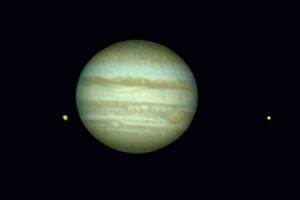
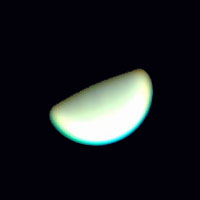
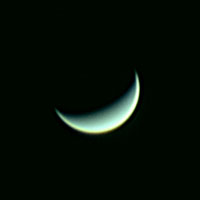 Venus When showing Venus to the public I often describe the planet as being as interesting look at as a cue ball. Indeed, Venus shows no details as it is covered by a perpetual layer of thick white clouds, no surface details can be seen and even the clouds are pretty boring compared to Jupiter's fanciful colored clouds. The only real interest in Venus is it phases. As Venus passes between Earth and the Sun it shows phases much like the Moon, down to a slim crescent near solar conjunction. As Venus is often spied low on the horizon the thick air makes this planet dance and break into multiple colors in the telescopic view.
Venus When showing Venus to the public I often describe the planet as being as interesting look at as a cue ball. Indeed, Venus shows no details as it is covered by a perpetual layer of thick white clouds, no surface details can be seen and even the clouds are pretty boring compared to Jupiter's fanciful colored clouds. The only real interest in Venus is it phases. As Venus passes between Earth and the Sun it shows phases much like the Moon, down to a slim crescent near solar conjunction. As Venus is often spied low on the horizon the thick air makes this planet dance and break into multiple colors in the telescopic view.
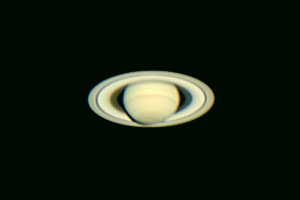
Saturn Always one of the "stars" of the show at any star party. Many people ask if they can see the rings in a telescope and the answer is a resounding yes! Again a night with steady air and a good telescope can help greatly, but even in a very small scope and not so great conditions the view is worth it. Look for the Cassini's division, the dark line in the rings and also look for the half dozen moons easily visible in a small telescope.
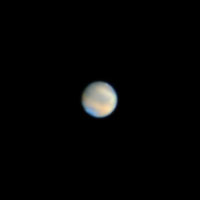 Mars Most of the time Mars is a little pale orange ball with little to see beyond a small disk and maybe some slightly lighter and darker areas.The photo at right is edited to simulate this appearance in the telescope.
Mars Most of the time Mars is a little pale orange ball with little to see beyond a small disk and maybe some slightly lighter and darker areas.The photo at right is edited to simulate this appearance in the telescope.
The real time to look at Mars is opposition. Every two years or so, Earth laps Mars in their endless race around the Sun and during that time we get a much closer view. 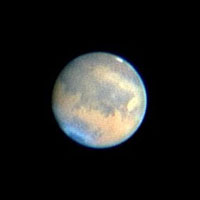 For a couple months either side of opposition Mars grows brilliant in the sky and this mysterious world is revealed to us. We can see the bright white polar caps as well as the light and dark albedo markings of the Martian terrain. Each opposition is eagerly awaited by observers.
For a couple months either side of opposition Mars grows brilliant in the sky and this mysterious world is revealed to us. We can see the bright white polar caps as well as the light and dark albedo markings of the Martian terrain. Each opposition is eagerly awaited by observers.
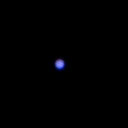
Uranus as seen in an 8 to 12 inch telescope at least 200x
Uranus and Neptune While a bit more challenging these outer planets are not that difficult to spot in a telescope as small as 6 or 8 inches. Both are visible with small telescopes, or even binoculars as a moderately bright star. With a good sized telescope both show as small blue and green disks of pale color very different than the bright pinpoint of a star.
Pluto It is possible to see Pluto in a telescope of at eight inches or greater, but even with larger telescopes it shows only as a dim 14th magnitude star. It is one dim star among hundreds and a challenging object at best, requiring patience and skill to locate.
The solar system has many denizens, among the most beautiful and the most unpredictable are the comets. Showing up when we least expect them, or not behaving as predicted these objects can be some of the most worthwhile targets for a telescope. While we usually know where to find them (the orbits are the one predictable element of comets) these objects can suddenly brighten, dim dramatically or even break apart. One comet ran into Jupiter and comets vaporizing in the intense heat near the sun are not unheard of. While there are always a few comets orbiting through the inner solar system most are challenging objects, small, dim balls of fuzz with little or no tail. But every few years a bright comet appears to remind us of the glory that can be a bright comet.
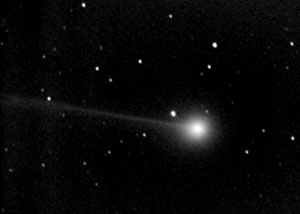
Shown is a photo of Comet Ikeya-Zhang shortly after discovery, showing a small tail and the coma. Typical comets have only the coma and little or no tail.
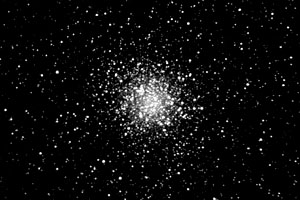 Star Clusters
Star Clusters
Clusters come in two different types; open clusters and globular clusters. Both can be beautiful to look at in a telescope with hundred or even thousands of stars scattered across the field. Often the stars show pale colors of orange, gold or blue. With star clusters dark skies can be truly helpful, but many look decent even under light polluted skies.
The photo shows M22, a bright globular cluster in Sagittarius, a pretty sight in any decent telescope, but truly stunning under dark skies and larger aperture.
Nebulas
Like star clusters, nebulas come in different types. For nebulas there are emission nebula, reflection nebulas, planetary nebulas, dark nebulas and supernova remnants. The one common element is that all nebula are gigantic clouds of gas and dust drifting through interstellar space.
This is where dark skies are valuable, many nebula are invisible against the bright urban skies of large cities and towns. To truly admire the nebula or galaxies dark skies are a necessity.
One thing you generally DO NOT see is color, the color sensitive cells in the human eye do not work very well at low light levels. The result is that you see nebulas in shades of grey. There are exceptions to this, several planetary nebulas and some brighter emission nebulas emit a fair amount of light at a blue green wavelength that is near the peak sensitivity of the human eye, the result is a pale blue green color that can just be seen. But again dark skies and larger apertures are needed to see these colors.
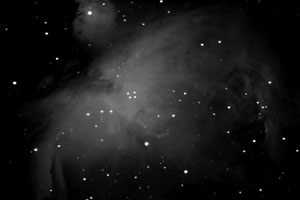
An image of M42 edited to simulate the view in a 8 or 10 inch telescope under dark skies.
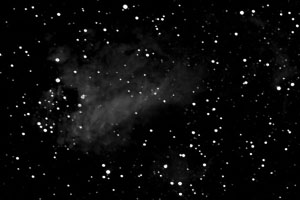
An image of M17 edited to simulate the view in a 8 or 10 inch telescope under dark skies.
Galaxies
The most distant things we normally look at with telescopes are the galaxies, systems of billions and trillions of stars that are millions of light years away. Forget seeing spiral arms unless you have truly dark skies and larger apertures, and even then only a few nearer and brighter galaxies will reveal their true structure. Most galaxies are dim fuzzy objects, often at the limit of detection in the telescope. But galaxies can still be rewarding objects to look at, edge-on spiral galaxies and the closer large galaxies will show structure and interesting detail to the dedicated observer.
Below: An edited view of NGC253 simulating the view with a large amateur telescope and dark skies.
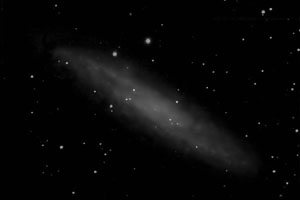
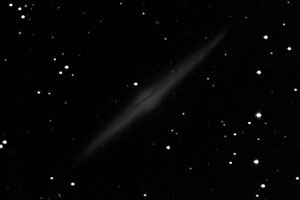
Above: A Photo Shop edited version of NGC4565, attempting to simulate what the view is in the telescope of a bright edge-on spiral galaxy would look like in a 10-inch or larger telescope under dark skies and good conditions.
For those that have mastered the basics of using a telescope and found many of the objects shown above there is much more to look at hidden among the stars; novas, supernovas, asteroids and quasars just a part of this long list. Eclipses and occultations change the appearance of old friends a few times a year. And when you thought you have seen it all the universe serves up something new every now and then to keep you setting up your telescope under a dark sky.
Photo Credits
All images are copyright Andrew Cooper, all rights are reserved, no use without permission. Many of the images are heavily edited to simulate the view in the average amateur telescope.